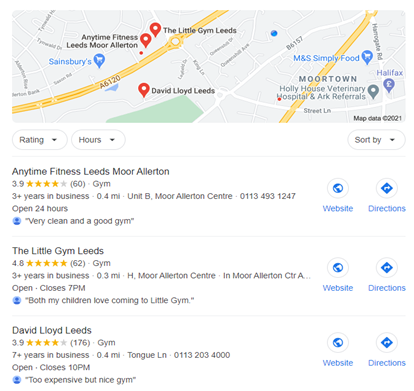Introduction to Local SEO
We are all familiar with the concept of SEO (search engine optimisation) and what SEO can do for a website. Essentially, the aim of SEO is to bring traffic to your website through natural search (we call it organic search) and build “brand awareness”.
But how is the concept of Local SEO different to “traditional” SEO and how can it help your business to grow in your local area?
With local SEO, it’s all about the way people are finding your dealership in the digital world. Without going too deep into numbers, let’s assume that almost half of users add local keywords on their searches, we would call this user local intent. On mobile devices, this is usually even higher, perhaps 75% of potential customers will search for something local as they are wanting to visit the store on the same day or in the near future, rather than be shown a number of results for dealerships in other areas.
The main objective is to work towards making your business more visible in your local area. The physical location of the user is the shining star. A customer’s location can be established by the users’ IP address on desktop, tablets, or laptops or even more importantly, by using the GPS location on a mobile phone.
Local SEO works with some key ideas: Proximity, Local Relevance, Prominence, Google Local Pack.
Proximity: In 2016 and 2019 respectively, Google updated their algorithm to prioritise businesses with the same postal code as the user, knowing that these results would be more relevant to them. Obviously, the tremors in local rankings were huge, with some businesses losing ground in some areas and gaining plenty of scope in others.
Local Relevance: is a group of “signals” that Google takes into account, such as keywords, domain authority (DA), meta tags, URL structure, NAP (acronym for Name, Address, and Phone number), Google my Business details, Citation Consistency, and more.
Prominence: it is simply how well your dealership stands in comparison with your competitors. Generally, a well-known brand will stand better in local searches than a similar small business but, (there is always a but), Google Reviews, plays an important role in changing this equation in your favour, if it is done correctly.
Google Local Pack: sometimes referred to as the 3-pack, map pack or snack pack, the Local Pack is an organic search result that appears just below the ad results, showing a map of nearby businesses and the top 3 most relevant local companies. This is usually shown when someone is looking for a specific service in that is local area or in a specific place. If you are shown in the 3-pack, it presents your business as an established company in your local area, giving a better chance of the customer clicking on your website.
Name, Address and Phone number
Then we come to the NAP, an acronym for Name, Address and Phone, which is hugely relevant for the Local Pack because Google not only shows local organic results when you add “service” plus “place”, it also assumes that your service is local even if your search does not contain a specific place.

Here’s an example of how the Map Pack shows the results for an ultra-basic search with only one word: “gym”.
Now you can see that Google has a specific algorithm for “local” with a set of different rules to the “normal” search. Another area to consider with Google My Business is “reviews”. These give the customer the sense of confidence that you are a real and trusted business. Reviews became a trust signal for Google and can massively work to your advantage.
It’s important that you create and optimise your Google My Business to perform well and shine on the map pack and SERP (Search Engine Results Pages) with dedicated keywords and detailed information.
Citation Consistency
Google learns to connect the information your business displays on review sites, business directories, phone directories, etc, so this information should be consistent across all of these entries, as it will act as a confidence factor that impacts your rankings.
Local businesses can benefit from data consistency and this can make a visible difference on the organic results building up Google “trust”.
Because Google algorithms change frequently, it is of capital importance to keep the NAP and Google my Business up to date and optimised with the proper keywords, plenty of relevant quality images and associated information. Other important information to have on your GMB listing is.
- The correct URL linking through to your website.
- Directions to your business.
- A way for the customer to get in touch.
Once your website is optimised, the worst mistake to make is the classic “set it and forget it”. Having a website and then telling nobody about it, without local SEO, will not drive customers to your website and you may miss out on vital leads.
Incorrect or inconsistent NAP data, location details and opening times can cause bad reviews which can drive your rankings down. For example, if an individual goes out of their way to visit a business, but when they arrive, they see that it is closed, despite their Google My Business profile saying they are open, this can have a negative impact on your business.
Another area that can be optimised for the Local Pack relates to backlinks. (A backlink is when another website, page, or web directory links to one of your website pages). Attracting local backlinks can transfer “link juice”, which helps your Domain Authority to increase not only in general, but more importantly, locally.
Being a local car dealer or a business owner, it is essential to optimise your website for Local SEO, involving local SERP and Map Pack to show on the first page of search engine results.
If you are low on resource or would rather outsource to our digital marketing specialists here at Autoweb Design, we are happy to help you create a successful strategy to bring your business to the top of its game, being visible online and steadily increasing your search engine ranking.

